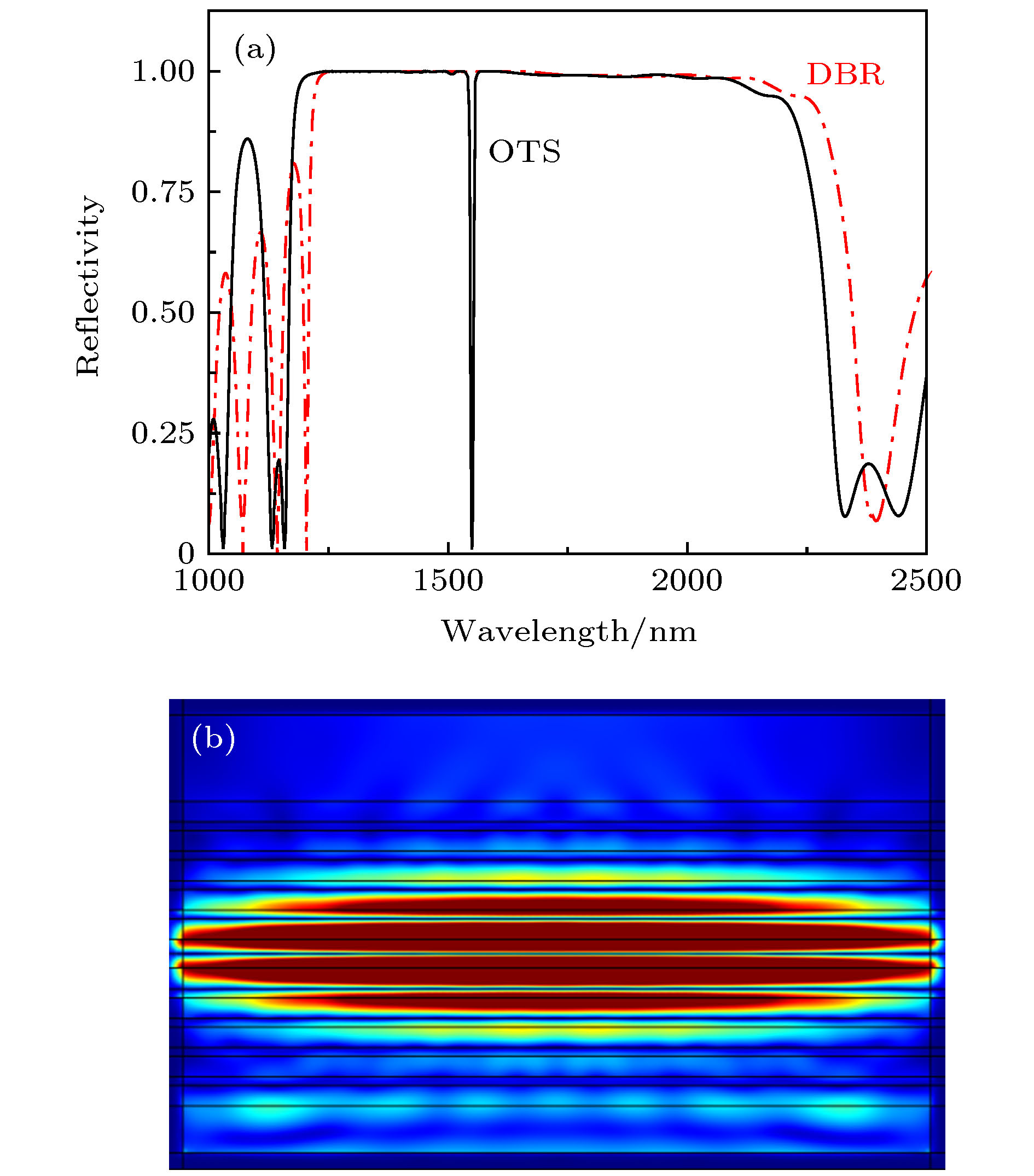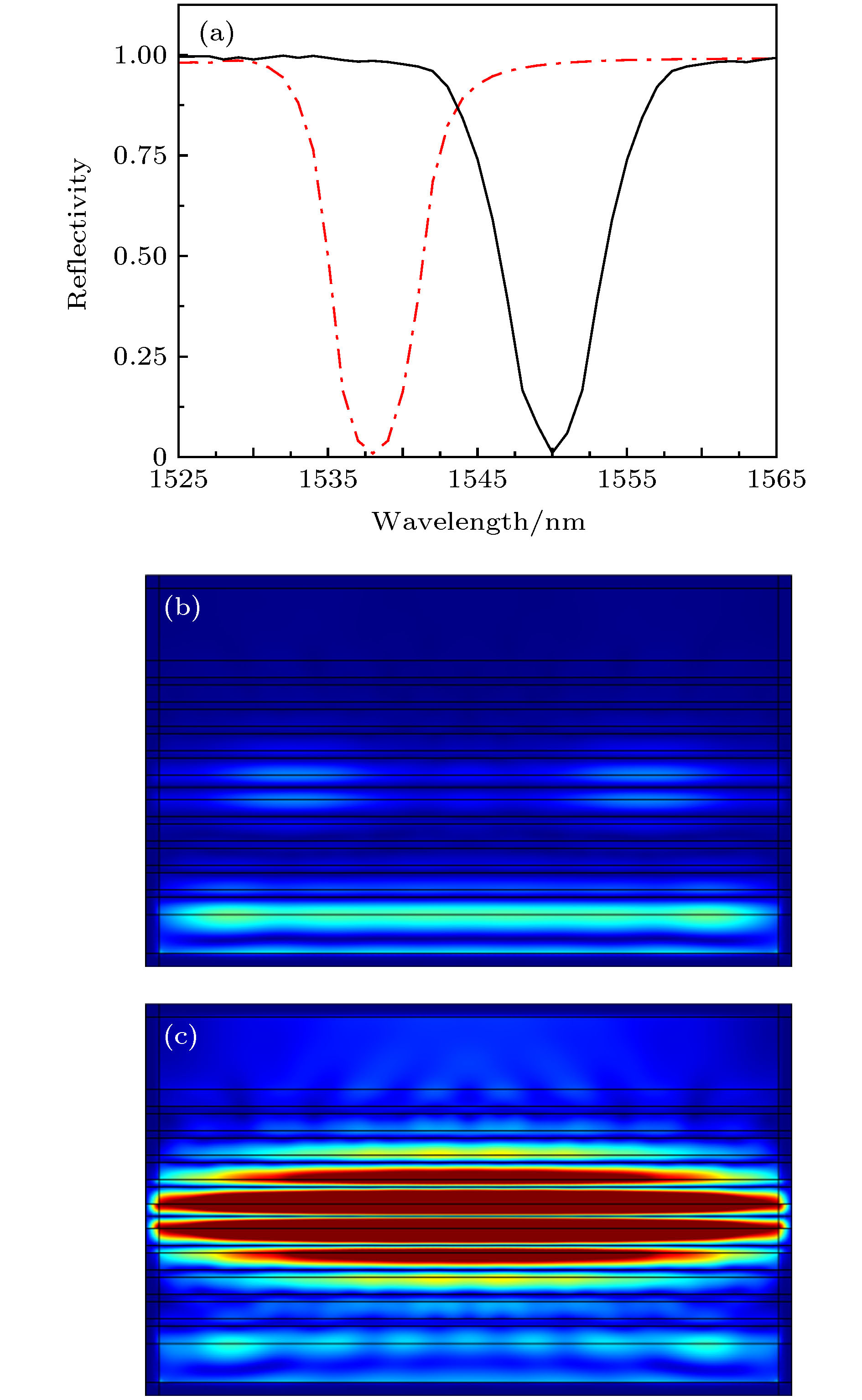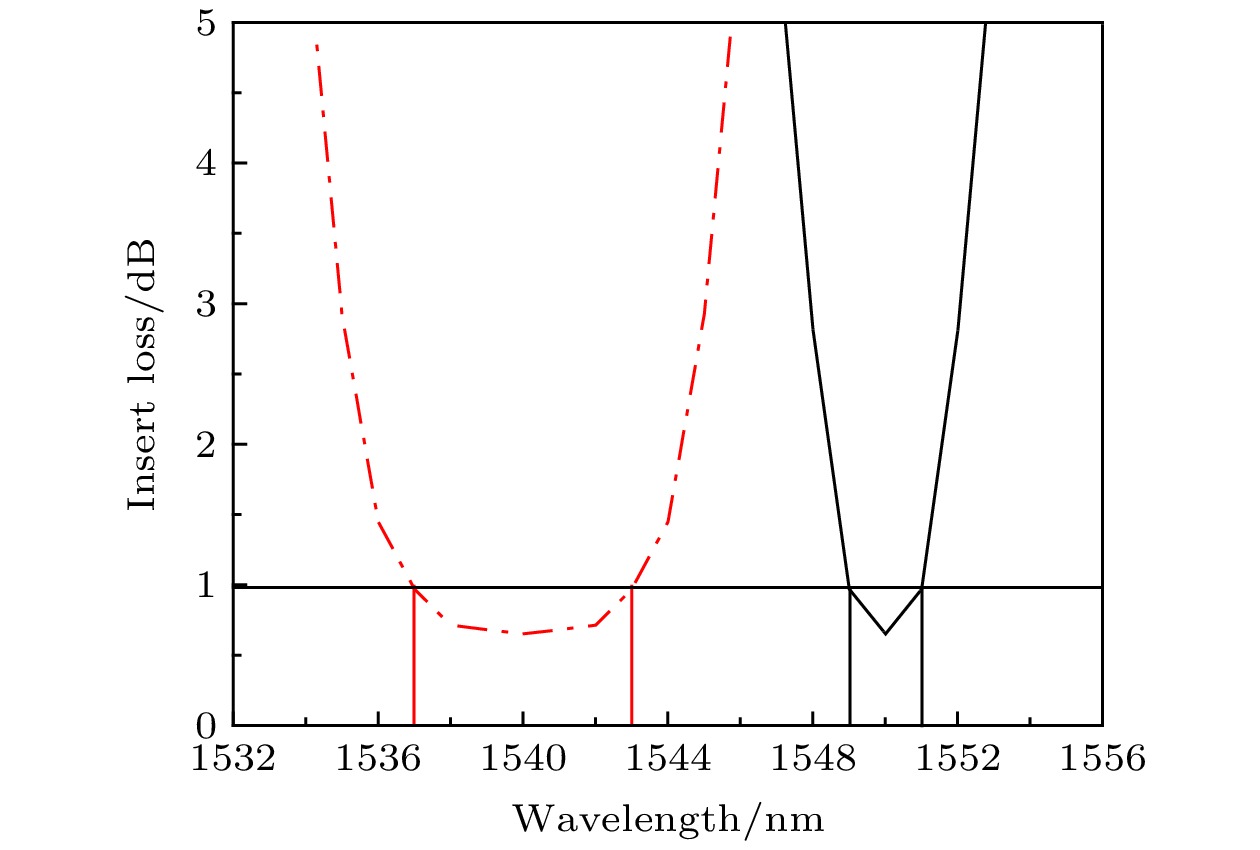-
An acousto-optic switch scheme based on optical tamm state (OTS) is proposed. The acousto-optic switch’s structure is one-dimensional photonic crystal heterostructure, which is composed of three materials: silicon dioxide, gallium arsenide and tellurium dioxide. All three materials are acousto-optic materials, which can ensure the acousto-optic effect when the ultrasonic wave and the light wave are incident at the same time. Due to the acousto-optic effect, the refractive index and thickness of one-dimensional photonic crystal heterostructures are changed by ultrasonic. The acousto-optic switch changes the ultrasonic amplitude to shift the intrinsic wavelength of OTS to the shorter wave direction. With the increase of ultrasonic amplitude, the intrinsic wavelength of OTS hardly changes after the amplitude exceeds 0.4 nm. This means that the ultrasonic wave with an amplitude of 0.4 nm can shift the intrinsic wavelength to 1538 nm. The acousto-optic switch realizes the on-off function within the permitted range. In this paper, the theoretical model of the acousto-optic switch is established. The propagation of ultrasonic wave in one-dimensional photonic crystal heterostructure is analyzed by theoretical model. The propagation of light in the medium after acousto-optic effect is analyzed by transmission matrix method. The simulation is carried out through COMSOL Multiphysics software. The results show OTS exists and localization can be seen in the electric field diagram. The acousto-optic switch of 1548.8–1551.7 nm can be realized by applying certain amplitude of ultrasonic or not. In this wavelength range, the extinction ratio is not lower than 12 dB and the insertion loss is not higher than 0.97 dB. The maximum extinction ratio is 13.17 dB, and the minimum insertion loss is only 0.65 dB. The acousto-optic switch of 1536.6–1543.3 nm can be realized by applying ultrasonic wave with amplitude corresponding to the length of incident light. In this wavelength range, the extinction ratio is not lower than 12 dB, and the insertion loss is not higher than 0.99 dB. The maximum extinction ratio is 13.15 dB, and the minimum insertion loss is only 0.65 dB. The response time of the acousto-optic switch is less than 13 ns. The acousto-optic switch has the characteristics of high extinction ratio and low insertion loss. It has a good application prospect and can be effectively applied in future optical communication.
-
Keywords:
- acousto-optic switch /
- optical tamm state /
- photonic crystal /
- acousto-optic effect
[1] 刘琳 2002 光纤与电缆及其应用技术 6 10
 Google Scholar
Google Scholar
Liu L 2002 Opt. Fib & Cab. Appl. Techno. 6 10
 Google Scholar
Google Scholar
[2] Giles C R, Aksyuk V, Barber B, Ruel R, Stulz L, Bishop D 1999 IEEE J. Sel. Top. Quantum Electron. 5 18
 Google Scholar
Google Scholar
[3] 尹鑫, 王继扬 2004 53 3565
 Google Scholar
Google Scholar
Yin X, Wang J Y 2004 Acta Phys. Sin. 53 3565
 Google Scholar
Google Scholar
[4] Cuadrado-Laborde C, Diez A, Cruz J 2011 Laser & Photonics Rev. 5 404
 Google Scholar
Google Scholar
[5] Chen Y, Ming H 2012 Photonic Sens. 2 37
 Google Scholar
Google Scholar
[6] Kavokin A V, Shelykh I A, Malpuech G 2005 Phys. Rev. B 72 3102
 Google Scholar
Google Scholar
[7] Goto T, Dorofeenko A V, Merzlikin A M, Baryshev A V, Vinogradov A P, Inoue M, Lisyansky A A, Granovsky A B 2008 Phys. Rev. Lett. 101 113902
 Google Scholar
Google Scholar
[8] 蒋瑶, 张伟利, 朱叶雨 2013 62 167307
 Google Scholar
Google Scholar
Jiang Y, Zhang W L, Zhu Y Y 2013 Acta Phys. Sin. 62 167307
 Google Scholar
Google Scholar
[9] Gabrys P, Seo S, Wang M 2017 Nano. Lett. 18 579
 Google Scholar
Google Scholar
[10] Rossi K, Baletto F 2017 Phys. Chem. Chem. Phys. 19 11057
 Google Scholar
Google Scholar
[11] Zhang Z, Li Y, Liu W 2016 J. OPTICS-UK 18 025103
 Google Scholar
Google Scholar
[12] Fang Y, Ni Y, He H, Hu J 2014 Opt. Commun. 32 99
 Google Scholar
Google Scholar
[13] 吴皓, 徐飞, 陆延青 2012 中国激光 39 105010
 Google Scholar
Google Scholar
Wu H, Xu F, Lu Y Q 2012 Chin. J. Laser 39 105010
 Google Scholar
Google Scholar
[14] 朱奇光, 董昕宇, 王春芳, 王宁, 陈卫东 2015 64 034209
 Google Scholar
Google Scholar
Zhu Q G, Dong X Y, Wang C F, Wang Y, Chen W D 2015 Acta Phys. Sin. 64 034209
 Google Scholar
Google Scholar
[15] Lin Y, Chang W, Wu C 2010 Opt. Express 18 26959
 Google Scholar
Google Scholar
[16] Xiao L, Liu Y, Wang W, Geng F 2006 Chin. Phys. Lett. 23 645
 Google Scholar
Google Scholar
[17] 李培丽, 高辉, 栾开智, 陆云清 2020 光谱学与光谱分析 40 650
 Google Scholar
Google Scholar
Li P L, Gao H, Luan K Z, Lu Y Q 2020 Spectrosc Spect Anal 40 650
 Google Scholar
Google Scholar
[18] 李乾利, 温廷敦, 许丽萍 2013 62 18
 Google Scholar
Google Scholar
Li Q L, Wen T D, Xu L P 2013 Acta Phys. Sin. 62 18
 Google Scholar
Google Scholar
[19] Qian X, Li J, Lu M, Lu Y, Chen Y 2009 J. Appl. Phys. 106 43107
 Google Scholar
Google Scholar
[20] Bandyopadhyay R, Chakraborty R 2015 Opt. Eng. 54 117105
 Google Scholar
Google Scholar
[21] 王磊, 李培丽 2018 光通信研究 209 63
 Google Scholar
Google Scholar
Wang L, Li P L 2018 Stud Opt. Commun. 209 63
 Google Scholar
Google Scholar
[22] Jandaghian A, Lotfalian A, Kouhkan M 2017 Opt. Eng. 56 12901
 Google Scholar
Google Scholar
[23] Takada K, Satoh S 2018 Appl. Optics. 57 5235
 Google Scholar
Google Scholar
-
图 4 声光开关施加振幅0.4 nm的超声波和不加超声波的反射谱及电场图 (a) 施加振幅0.4 nm的超声波和不加超声波的反射谱; (b) 不加超声波1538 nm处电场图; (c) 施加振幅0.4 nm的超声波1538 nm处电场图
Figure 4. Reflection spectrum and electric field diagram of ultrasonic wave with amplitude of 0.4 nm and without ultrasonic wave: (a) The reflection spectrum of the acousto-optic switch with 0.4 nm amplitude applied and without ultrasonic; (b) electric field diagram at 1538 nm without ultrasonic; (c) electric field diagram at 1538 nm with amplitude of 0.4 nm ultrasonic wave.
-
[1] 刘琳 2002 光纤与电缆及其应用技术 6 10
 Google Scholar
Google Scholar
Liu L 2002 Opt. Fib & Cab. Appl. Techno. 6 10
 Google Scholar
Google Scholar
[2] Giles C R, Aksyuk V, Barber B, Ruel R, Stulz L, Bishop D 1999 IEEE J. Sel. Top. Quantum Electron. 5 18
 Google Scholar
Google Scholar
[3] 尹鑫, 王继扬 2004 53 3565
 Google Scholar
Google Scholar
Yin X, Wang J Y 2004 Acta Phys. Sin. 53 3565
 Google Scholar
Google Scholar
[4] Cuadrado-Laborde C, Diez A, Cruz J 2011 Laser & Photonics Rev. 5 404
 Google Scholar
Google Scholar
[5] Chen Y, Ming H 2012 Photonic Sens. 2 37
 Google Scholar
Google Scholar
[6] Kavokin A V, Shelykh I A, Malpuech G 2005 Phys. Rev. B 72 3102
 Google Scholar
Google Scholar
[7] Goto T, Dorofeenko A V, Merzlikin A M, Baryshev A V, Vinogradov A P, Inoue M, Lisyansky A A, Granovsky A B 2008 Phys. Rev. Lett. 101 113902
 Google Scholar
Google Scholar
[8] 蒋瑶, 张伟利, 朱叶雨 2013 62 167307
 Google Scholar
Google Scholar
Jiang Y, Zhang W L, Zhu Y Y 2013 Acta Phys. Sin. 62 167307
 Google Scholar
Google Scholar
[9] Gabrys P, Seo S, Wang M 2017 Nano. Lett. 18 579
 Google Scholar
Google Scholar
[10] Rossi K, Baletto F 2017 Phys. Chem. Chem. Phys. 19 11057
 Google Scholar
Google Scholar
[11] Zhang Z, Li Y, Liu W 2016 J. OPTICS-UK 18 025103
 Google Scholar
Google Scholar
[12] Fang Y, Ni Y, He H, Hu J 2014 Opt. Commun. 32 99
 Google Scholar
Google Scholar
[13] 吴皓, 徐飞, 陆延青 2012 中国激光 39 105010
 Google Scholar
Google Scholar
Wu H, Xu F, Lu Y Q 2012 Chin. J. Laser 39 105010
 Google Scholar
Google Scholar
[14] 朱奇光, 董昕宇, 王春芳, 王宁, 陈卫东 2015 64 034209
 Google Scholar
Google Scholar
Zhu Q G, Dong X Y, Wang C F, Wang Y, Chen W D 2015 Acta Phys. Sin. 64 034209
 Google Scholar
Google Scholar
[15] Lin Y, Chang W, Wu C 2010 Opt. Express 18 26959
 Google Scholar
Google Scholar
[16] Xiao L, Liu Y, Wang W, Geng F 2006 Chin. Phys. Lett. 23 645
 Google Scholar
Google Scholar
[17] 李培丽, 高辉, 栾开智, 陆云清 2020 光谱学与光谱分析 40 650
 Google Scholar
Google Scholar
Li P L, Gao H, Luan K Z, Lu Y Q 2020 Spectrosc Spect Anal 40 650
 Google Scholar
Google Scholar
[18] 李乾利, 温廷敦, 许丽萍 2013 62 18
 Google Scholar
Google Scholar
Li Q L, Wen T D, Xu L P 2013 Acta Phys. Sin. 62 18
 Google Scholar
Google Scholar
[19] Qian X, Li J, Lu M, Lu Y, Chen Y 2009 J. Appl. Phys. 106 43107
 Google Scholar
Google Scholar
[20] Bandyopadhyay R, Chakraborty R 2015 Opt. Eng. 54 117105
 Google Scholar
Google Scholar
[21] 王磊, 李培丽 2018 光通信研究 209 63
 Google Scholar
Google Scholar
Wang L, Li P L 2018 Stud Opt. Commun. 209 63
 Google Scholar
Google Scholar
[22] Jandaghian A, Lotfalian A, Kouhkan M 2017 Opt. Eng. 56 12901
 Google Scholar
Google Scholar
[23] Takada K, Satoh S 2018 Appl. Optics. 57 5235
 Google Scholar
Google Scholar
Catalog
Metrics
- Abstract views: 9453
- PDF Downloads: 109
- Cited By: 0















 DownLoad:
DownLoad:






